Larry D. Marshall's Blog, page 92
March 2, 2014
Winter Building Sketching
I’m desperate. I really am a building sketcher and winter sends me indoors, to museums, concerts, etc. Not many buildings to be found inside buildings.
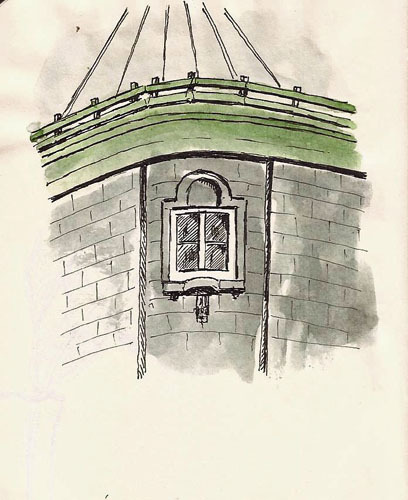
This is a view if you sit on the second floor of the McDonalds on St. Jean St. in old Quebec, McCafe in hand. Stillman & Birn Alpha 4×6), Platinum Carbon pen, Platinum Carbon ink
But when there’s a will, there’s a way, at least in a limited fashion. If one is lucky, one can sit by the window in a coffee shop and sketch the outdoors. I searched a bit and got lucky. Here’s a couple small sketches I did while looking out of windows. I’m ready for spring. How about you?

This one was hard to do as I had to lean over a bench and a heater so I could look out a small window in the old jail that’s now associated with the art museum in Quebec City. It was to see and balance sketchbook at the same time. Stillman & Birn Alpha (4×6), Platinum Carbon pen.
March 1, 2014
Sketching Hotel St-Antoine In Quebec City
Next to my winter sketching grounds, the Musée de la Civilisation, is one of the finest hotels in Quebec City. I doubt I could afford to rent a broom closet for the night. But one very cold day, when we’d arrived at the museum too early and were standing around, waiting for it to open, Claudette suggested we visit the Hotel St-Antoine, a ploy to get inside some place…any place.
Once we were there, however, we saw great potential as a sketching opportunity. Not only is the hotel gorgeous, throughout its corridors and lobby area are shadow boxes built into the wall that are filled with artifacts from the 1600-1800s, mostly dug up from what is now called Place Royal, where the hotel is situated. We vowed to return.
And we did and found the staff very accommodating. They gave us permission to sketch and I concentrated on an area near the entrance, which is something of a posh sitting/lunch/reading room. We had so much fun there. It was also fun that the staff were telling their buddies about our activities and one after the other they came by to see our sketches. It was great fun and their kind comments good for our egos (grin). They even offered us a cup of coffee.
 Here are two sketches done in that lobby area. Both were done in a Stillman & Birn Alpha (10×7) using a Pilot Prera and diluted Lexington Gray. I’ll be returning to sketch some of the items in their shadowboxes ‘real soon.’
Here are two sketches done in that lobby area. Both were done in a Stillman & Birn Alpha (10×7) using a Pilot Prera and diluted Lexington Gray. I’ll be returning to sketch some of the items in their shadowboxes ‘real soon.’
February 25, 2014
Clowns In Paris
The Paris 1900 exhibit at our Musée de la Civilisation has come to an end. The real significance of this is felt most by we sketchers, who use the museum as our winter gathering spot and this winter that exhibit has been the center of our activity. It departure leaves us with a large display of video game history (how many boxes and monitors can you sketch?) and a display of Haiti junk art titled “Haiti Extremis” and it lives up to its name. Weird stuff.
Before the exhibit was shut down, though, I decided that I needed to draw “the clown.” He’s part of a very large mural painted by Fernand Pelez, who depicts tired and sad circus performers. I’ve reported previously on my attempt to sketch the musicians in this painting. The clown seems a fitting end to this exhibit for me. Done in a Stillman & Birn Zeta (6×9) with a Pilot Prera, Lexington Gray ink. I wonder where we’re going to sketch now 
February 23, 2014
Sketching To Music
 In Québec City there is a sketching group called Collectif des ateliers en arts visual de Québec. Yes, the name is far too long and it forms an acronym that’s completely unpronouncable (CALAVQ). Naming things is not the strong suit of Quebecers, but it is a great organization that organizes life drawing and portrait workshops among other art-related events.
In Québec City there is a sketching group called Collectif des ateliers en arts visual de Québec. Yes, the name is far too long and it forms an acronym that’s completely unpronouncable (CALAVQ). Naming things is not the strong suit of Quebecers, but it is a great organization that organizes life drawing and portrait workshops among other art-related events.
Lucien Provost is the president of this group and he arranged for ten of us to spend the day sketching at the Conservatoire de musique de Québec, courtesy of its director, Louis Dallaire, and several of his very accomplished and accomodating students who played for us while we sketched them. They were:
Julie C. Villeneuve, oboe and English horn
Étienne Chenard, violin
Alejandro Calzadilla, alto saxophone
Guillaume Turcotte, cello
and a trio:
Jean-Michel Dubé, piano
Romain Rocher, violon
Paola Curcio-Rizzato, cello

Julie Villeneuve -
Hero 9018 bent-nib pen, J.Herbin 1670 ink.
Thanks to all of you who gave of your time and facilities to make a bunch of sketchers very happy.
The music was amazing. The students were fun. Julie’s dress was simply spectacular. And the sketching was non-stop. We started at few minutes after 10AM and finished at 3PM, with 15 minutes for lunch. To say it was intense is to understate the situation. I ended up with 17 pages of sketches, some better than others I should add.
I’ll share just a few of them with you. I spent the day trying different pens and have indicated which were used in each case. The sketchbook was a Strathmore “Toned Gray” 6×9 book. Clicking on the images will enlarge them.

Detail of Julie’s sleeve shrouds – Hero 9018, J.Herbin 1670

One of the sketchers – Hero 9018/J.Herbin 1670 and Hero 578/Platinum Carbon Black

Some details & Guillaume’s face – Platinum Prera, Lexington Gray
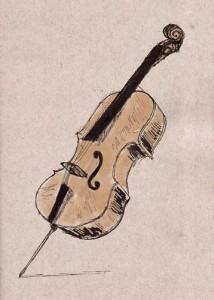
cello – Pilot Prera, Lex Gray, Hero 578, Platinum Carbon Black
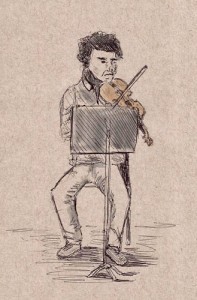
Romain Rocher, Pilot Prera, Lex Gray
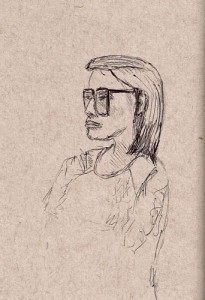
Paola Curcio-Rizzato, ballpoint pen
February 19, 2014
1898 Renault-Tilbury Car Sketch
A couple days ago I posted a sketch of the back end of a Renault car that putted its way through Paris in 1900. When I look at it I see Mr. McGoo driving.
I got back to the museum yesterday and sketched the front end of that same car. I regret that I did it too fast and drew the wheels too thin but, caveats aside, I think it’s cute as a bug. Maybe I was channelling Mr. McGoo cartoons as I sketched.

Stillman & Birn Zeta (6×9), Pilot Prera, Lexington Gray
February 16, 2014
Sketchers Are Never Bored…Mostly
I’ve made the comment several times, here and elsewhere, that sketchers are never bored. When I’m sitting in a doctor’s office there are people to sketch. When I’m waiting for the car to be serviced there’s all sorts of stuff to sketch. I drew a billboard the other night while waiting to pick up my daughter. And when there’s nothing on TV I can always sketch scenes in the commercials. I’ve been known to draw pages full of lines, ellipses, and circles, too.
But I’ve been bored…REALLY bored. The flu has a way of eliminating all notion of sketching, thinking, looking, seeing, and about the best I could do over the past few days has been to sit and become over-dosed on Olympics coverage.
Today the residual ‘tuckered out’ feeling was all that remained of my bout with a gaggle of viruses and I wasn’t going to let that stop me. I headed to the museum to meet up with Yvan for a sketching session. I’m afraid I’m still a bit less than optimal but I managed this sketch. There is an 1898 Renault Mini-Car on display and while I have to get around to the front of it for a sketch, I just love this view from the rear as it shows off its red running gear.

Stillman & Birn Zeta (6×9), Pilot Prera, Lexington Gray
February 14, 2014
The Sketches That Don’t Get Posted
I’ve never done a count but I think that I post less than 50% of the sketches that I do. I know this is true if I include my constant doodling. Sketching is about learning to see, hand-eye coordination and building a vocabulary to turn 3D images into 2D sketches. While stated often by experts, I think most want to believe that there’s some way to get past the need to practice, practice, practice.
Because of this constant sketching I generally have sketches to post but, right now, I’m sick. Mr. Flu came to visit our house and I’ve spent the last few days staring at Olympics and debating whether living or dying was the best course of action. Such is the nature of Mr. Flu. Because of this, I haven’t done much sketching.
But this morning I read a great post by Tina Koyama. She came across a couple of her sketches that she’d forgotten about and decided to share. They were great and appreciated that she took the time to post them.
Her post made me think of all the sketches that never see the light of day and gave me an idea. In defiance of Mr. Flu, I offer this little doodle I did while looking out the window at three people who were walking slowly down the sidewalk in front of our house. No big deal and the middle guy’s head seems too large to me, but heck, it’s not bad given that I had a 102F temperature at the time.

Canson Ingres paper, Hero 578 pen
February 12, 2014
Never Ask A Sketcher What Is It?
Anyone who is a parent has faced the uncertainty of responding to a young child’s beaming face as she looks up, waving a paper in the air and says, “Mommy, look what I made.” The parent looks at the blob of color on the paper. They note a roundish form, drawn in gray, four projections and some scribbles on top where a head might be. Is it an elephant? A cat? Or is it me? Only parents can properly negotiate that mine field.
And so it goes with sketchers, but with less delicacy I’m afraid. When I brought my latest sketch home my Quebecois wife said, as she always does, “C’est beau,” but this time with puzzlement on her face. Then, something she would never do when our daughter was growing up she blurted, “What the heck is it?”
My daughter came into the room, looked at the sketch and said, without any fanfare, “What is that thing?” Obviously she has learned nothing from the finesse with which we greeted vague forms made from little hands with the best that Crayola had to offer.
In this case, however, maybe I can forgive them. It’s not something you see every day – or ever for that matter. We don’t make stuff this elegant anymore. But back at the turn of the 19th Century, those promoting the idea of subways felt the need to make them look spectacular because, for most people, the thought of going underground was, well, creepy. This cast iron beauty is an entry gate from the 1900 Paris subway.
The sketch was done at the Musée de la Civilisation museum, in the Paris exhibit. Eighty-six of these gates were made. I’d hate to have to draw all of them. One was enough to generate smoke from my ears.

Stillman & Birn Zeta (6×9), Pilot Prera, Noodler’s Lexington Gray
February 9, 2014
The Power of the Hero “bent-nib” Pen
Some sketchers love watercolors. Others are passionate about line. And, of course, there are those who do a combination of the two, with varying emphasis on one or the other.
For myself, if I had to do one or the other, line work, particularly that made by fountain pen, would be my choice. My use of watercolor is similar to what I did with crayons when I was a kid – I “color” inside the lines.
My lines tend to be thin and my favorite pens are those that produce them. Pens like the Pilot 78G, Pilot Prera, and Platinum Carbon pen are among my favorites. My TWSBI Mini produces a slightly heavier line but even it is finer than the typical “medium nib” pen.
One intriguing exception in my personal fountain pen mountain (and I swear that I need them all) are my Hero “calligraphy” pens. Some call them “bent nib” pens. The “calligraphy” moniker is misleading for western-worlders as they don’t work at all like western calligraphy pens but are, rather, designed for writing Chinese characters. You affect line width by varying the pen angle rather than pen direction as with a western calligraphy pen.
There are several companies that produce them but Hero is the company that seems to make the largest number of models. They are available in North America for not much money via eBay but one must be careful to ensure you’re getting a calligraphy pen as Hero makes standard fountain pens as well.
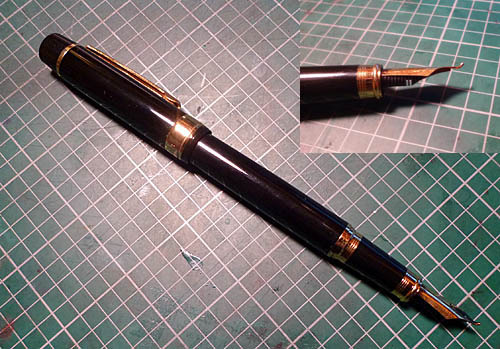
Hero 578 fountain pen. Note bent tip.
I have several of them and I’ve played with them some but have never taken them seriously. I’ve decided to change that and really learn to use them. To me, their big advantage is the ability to generate very wide lines as well as fine ones, permitting the creation of larger dark areas in a pen sketch. Their downside is that I can’t get as fine a line as I can from some of the other pens I’ve mentioned.
I was out the other day and I did this quick sketch from the 2nd floor dining area of our downtown McDonalds. You can see how even an inexperienced person like myself can generate high contrast sketches using the pen. Here I’m using a Hero 578, which is a fairly heavy pen but I like how it feels in my hand.
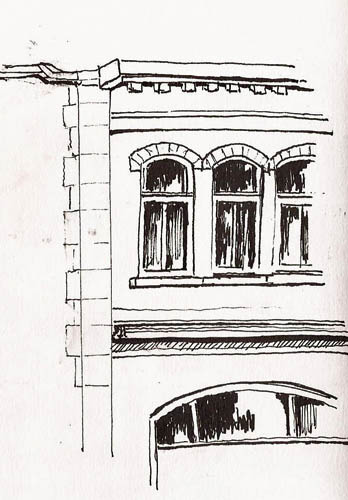
Stillman & BIrn Alpha (4×6), Hero 578, Platinum Carbon Black
Later, while at the Musée d’Amerique Français I sat in a comfy chair, looked out the window and sketched this portion of one of the seminary buildings.
The folks who have the most experience with these pens are the Singapore urban sketchers. Maybe with some practice I can begin to emulate them.

Stillman & Birn Alpha (4×6), Hero 578, Platinum Carbon Black
February 7, 2014
The Missing Sketching Equipment
Most books on sketching will start by telling you how much fun sketching is and how little equipment is required to do it. A pencil and a piece of paper is sufficient, they say. And it’s true…sort of. But it’s a lot more fun if you buy one of each kind of pencil, pen and paint and try every flat drawing surface on the market today…or so it seems if I look around my office.
If you’re a street sketcher, however, there are other things you need. The most basic thing, of course, is something in which to carry your one of everything, or some subset thereof. AND, if you’re like me and aren’t comfortable sketching while standing, you need a stool.
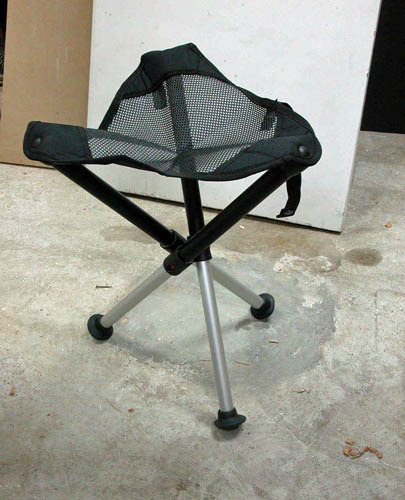 I carry a Walk Stool myself. I’ve owned it for a couple years and use it several times a week. In spite of this heavy use it still looks like new. It’s light; it’s comfortable; and it folds up small. But it only works if you take it with you and that was my problem last Tuesday when I went to the Musée de la Civilisation to sketch. I’d forgotten to put it in my bag.
I carry a Walk Stool myself. I’ve owned it for a couple years and use it several times a week. In spite of this heavy use it still looks like new. It’s light; it’s comfortable; and it folds up small. But it only works if you take it with you and that was my problem last Tuesday when I went to the Musée de la Civilisation to sketch. I’d forgotten to put it in my bag.
There were lots of things to sketch. There were lots of places to sit. The problem was that they weren’t in the same place. I wandered, and wandered, looking for a place that would provide both subject and seat. About the third circuit of the museum I my criterion for a suitable place reached a sufficiently low point that I realized that I could sit in the hallway and look through windows at the back of some of the exhibits in the Native American exhibition. The back of this dancer is the result.

Stillman & Birn Zeta (6×9), TWSBI Mini, Platinum Carbon Black





